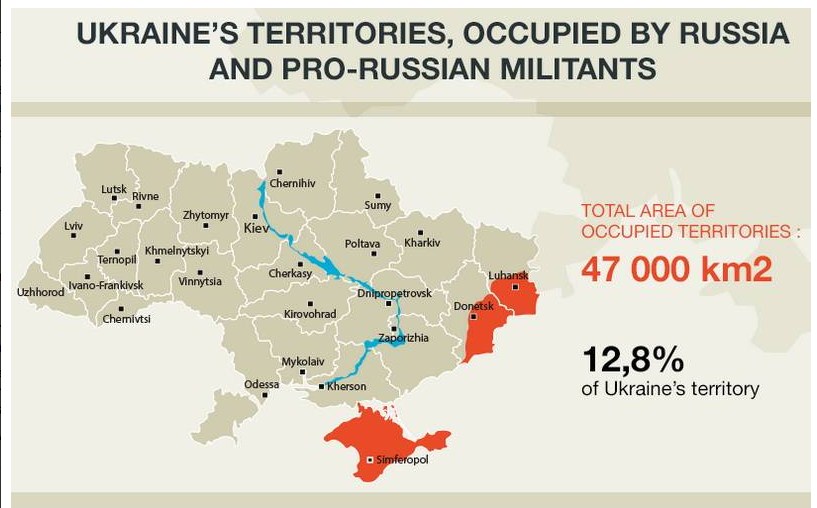Abstract
In theory, various territorial self-government arrangements (e.g. federalization, decentralization of power) are considered conducive to the resolution of intra-state territorial conflicts. Can such tools also work in the case of a conflict, marked by extensive foreign involvement? To answer this question, we will examine the linkage between the decentralisation reform in Ukraine and conflict resolution in Eastern Ukraine. A particular emphasis will be made on the implications of the local elections 2020 on both the future of the decentralisation reform and the aspired reintegration of currently uncontrolled territories.
Introduction
Intra-state territorial conflicts are often marked by a protracted and violent nature. They are, however, “not beyond settlement, as many examples of territorial [TSG] self-governance arrangements illustrate” (Wolff, 2017, p.1). Such arrangements offer “a compromise between the highly centralized, unitary state, at one end of the spectrum and the redrawing of international boundaries on the other” (Ibid). Among the successful cases of the TSG arrangements’ application, scholars mention Bosnia and Herzegovina (federalization), Northern Ireland (devolution, i.e. arrangements as to power-sharing are provided for not in the UK’s domestic law but its international agreement with the Republic of Ireland) and Kosovo (decentralisation).
The case of Ukraine is different from the above cases for two reasons. First of all, the “conflict in and around Ukraine” cannot be regarded as an interstate conflict. As it was officially acknowledged by the International Criminal Court (ICC), the conflict embraces an inter-state dimension, with Russia’s extensive political, financial and military support to the self-proclaimed Donetsk and Luhansk People’s Republics (“DPR” and “LPR”) (International Criminal Court, 2018, p.21). Second, the decentralisation reform, being implemented in Ukraine since 2014, is politically and legally disentangled from the efforts, directed to conflict resolution and the reintegration of uncontrolled territories (Rabinovych, 2020). Bearing these peculiarities of the Ukrainian case in mind, let us proceed with background information as to the decentralisation reform in Ukraine, its linkage to conflict resolution, and the most recent local elections’ implications for both agendas in question.
Decentralisation Reform in Ukraine
Ukraine’s decentralisation reform is narrated as a success story among the post-Euromaidan reforms. The key declared objective of the reform has been to improve the territorial communities’ capacity to create and support the better ‘living space’ for citizens, deliver better-quality public services and ensure the functioning of local democracy. The Concept of Reforming Local Self-Governance and Territorial Organization of Power in Ukraine envisages two reform phases (Cabinet of Ministers of Ukraine, 2014):
Phase I provided for the amalgamation of local territorial communities and the creation of legal prerequisites for broadening their competences and available financial resources. Over the period from 2014 to 2020, 1470 amalgamated territorial communities (ATCs) brought together more than 5000 previously existing small communities. Changes were also introduced to the Budgetary and Tax Codes of Ukraine to broaden the revenue sources, available to expand the revenues of local budgets and offer new transfers from the State Budget to local budgets for the ATCs’ development. Such transfers (subventions) were introduced in the domains of regional development, infrastructure development, as well as education and health services (since authorities in the educational and health domains were transferred from local state administrations to the newly formed ATCs).
Phase II to be completed until the end of 2021 focuses on rayons (subregional entities), optimizing their size and improving capabilities. 136 new rayons are to substitute previously existing 490 ones.
With more than a fourfold increase in local budgets’ revenues and numerous projects, funded via the new forms of transfers, the decentralisation reform has delivered much in economic development terms. Several crucial issues, however, remain unresolved in political terms.
Firstly, no agreement was reached at to the originally envisaged abolition of local state administrations and the creation of the institute of prefects – state representatives in rayons, responsible for overseeing the observance of the Constitution and legislation of Ukraine by the ATCs’ leaders. Second, despite the fundamental nature of change, brought forward by the decentralisation reform, no changes as to the new organization of local self-governance were introduced into Ukraine’s Constitution. And this is exactly where the linkage to conflict resolution comes into play.
Decentralisation and Conflict Resolution
As we mentioned earlier, the Concept of Reforming Local Self-Governance and Territorial Organization of Power in Ukraine does not mention the contribution to conflict resolution among the reform’s objectives. It is, however, the Minsk II Agreement, concluded as a result of international peace talks, that provides for the implementation of constitutional reform in part related to the decentralisation of power and the permanent special status of particular districts of Donetsk and Luhansk regions. In this vein, the non-constitutionalisation of changes, brought about by the decentralisation reform, stems from the challenges of the Minsk Agreement’s implementation. Since 2015, the Parties have been unable to find consensus as to the order of implementing the commitments under the Minsk Agreement. The Russian Federation insists on Ukraine to be the first to comprehensively execute its political commitments under the Minsk II. Ukraine refuses to do so, emphasizing the lack of progress in the security domain. A more specific divisive issue deals with the order of conducting local elections at currently uncontrolled territories (as provided for by the Minsk Agreement) and the transfer of control over the border with currently uncontrolled territories to Ukraine. Hence, in its current form and at the current stage of peace talks, the decentralisation reform does not immediately constitute a prerequisite for conflict resolution.
As I demonstrated in my previous contribution on the decentralisation-conflict resolution nexus, the decentralisation reform may, however, indirectly foster conflict resolution and the reintegration of Donbas in several ways (Rabinovych, 2020). They include:
- strengthening the ATCs’ resilience (due to the communities’ stronger control over the “making” of local politics and local development, new funding sources and the improvement of socio-economic opportunities for citizens)
- promoting social cohesion through the ATCs’ cooperation and
- “creating the foundation for a qualitatively different life in the uncontrolled territories after reintegration” (Rabinovych, 2020) through addressing the long-standing self-governance challenges in the Donbas area, such as low-quality public services, the lack of a region- and communities’ specific development agenda and democracy mechanisms.
Nonetheless, as it can be perfectly illustrated by the 2020 local elections that took place in the territory controlled by Ukraine, the decentralisation reform has brought about new risks that may potentially hinder conflict resolution.
Local Elections 2020 and the Risks of Decentralisation
The scale of local campaigns at the elections in 2020 convincingly demonstrates: the decentralisation of power is hardly reversible, and local politics becomes ever more important.
In the ideal world, both decentralisation and the revitalization of local politics would have been about the redistribution of competencies and stronger subsisiarity, rather than the weakening of central power. In Ukraine’s case, this seems to be the opposite. The local elections of 2020 consolidated strong positions of established mayors and local elites in all the key cities, such as Kyiv, Odesa, Kharkiv, Dnipro and L’viv. At the same time, as it can be demonstrated by the mayors’ reactions to the COVID-19 restrictions, they demonstrate ever stronger readiness to oppose and even openly disregard the decisions, adopted by the Cabinet of Ministers of Ukraine (the central executive body). Additionally, such a readiness increases due to the lack of the central government’s strong legal response to the mayors’ actions.
Furthermore, a crucial factor, potentially contributing to an increase in conflict, is the polarization of Ukrainians’ political preferences. While pro-European candidates are preferred in Central and Western Ukraine, the South-East demonstrates an increase in the affinity to the openly pro-Russian party “Opposition Platform – For Life” and pro-Russian candidates.
Alongside the political and foreign policy issues, conflict potential may also rise, given the lack of a clear strategy on Donbas’ future, shared by the stakeholders at different levels of governance. Parallel to the elections of 2020, President Zelenskyy conducted a consultative Survey, with one of the questions, dedicated to the prospect of creating a free economic zone in Donbas as a part of the reintegration scenario. Even amid the contestations as to the Survey’s legality and the lack of clarity as to the contents of the ‘free economic zone’ plan, the Survey demonstrated a high extent to which the economic dimension of Donbas’ future is contested in the rest of Ukraine. As a response, the government announced it also considers the creation of a free economic zone in the Western part of the country.
The Way Forward
Several months after the first post-decentralisation elections, where does Ukraine stand? The moods seem to be shaped by the weakening of the central government amid the rise of local politics – marked by the distrust to the center, the polarization of political preferences and –the communities’ broadened access to resources. Eager to further consolidate voters’ support, most of the local elites resemble little interest to the issues concerning conflict resolution and the reintegration of Donbas. This remains the center’s ‘business’ and becomes an ever more challenging ‘business’ due to the stalemate of the Minsk II talks and the gradual strengthening of Russia’s influence in the uncontrolled territories, including the provision of Russian passports to citizens in Donbas. Hence, while decentralisation offers several pathways to indirectly promote Donbas’ reintegration, at current stage it leaves the central government with two crucial security challenges, i.e. finding new options to facilitate the deoccupation and reintegration of uncontrolled territories, as well as the legal means to prevent legal uncertainty, arbitrariness and possible ‘centrifugal’ moves at the local level.
Rabinovych, M. 2021. ‘Decentralisation and Conflict Resolution in Ukraine: The Way Forward’, 50 Shades of Federalism.
References
Cabinet of Ministers of Ukraine (2014). The Concept of Reforming Local Self-Governance and Territorial Organization of Power in Ukraine. Available at: https://zakon.rada.gov.ua/laws/show/333-2014-%D1%80#Text [Accessed 13 November 2020].
International Criminal Court (2018). Report on Preliminary Examination Activities 2018. Available at: https://www.icc-cpi.int/itemsDocuments/181205-rep-otp-PE-ENG.pdf[Accessed 13 November 2020].
Rabinovych, M. (2020). Decentralization from the Perspective of Territorial Self-Governance and Conflict Management. Forum for Ukrainian Studies. Available at: https://ukrainian-studies.ca/2020/07/17/ukraines-decentralization-from-the-perspective-of-territorial-self-governance-and-conflict-management /[Accessed 13 November 2020].
Wolff, S. (2017). Options for Territorial Self-Governance: Decentralization, Devolution, Autonomy, and Federation. Social Science Research Council Working Papers. Available at: http://webarchive.ssrc.org/working-papers/CPPF_Models%20of%20Autonomy_5_Wolff.pdf [Accessed 13 November 2020].
Further Reading
Keil, S., Anderson, P. (2018). Decentralization as a Tool for Conflict Resolution. In: K. Detterbeck and E.Hepburn (eds.) Handbook of Territorial Politics. Cheltenham: Edward Elgar Publishing, pp.89-104.
Shelest, H., Rabinovych, M. (eds.) (2020)Regional Diversity, Decentralization and Conflict. The Case of Ukraine.Basingstoke: Palgrave McMillan.
Umland, A. (ed.) (2018). Ukraine’s Decentralization: Challenges and Implications of the Local Governance Reform after the Euromaidan Revolution. Stuttgart: ibidem-Verlag.


